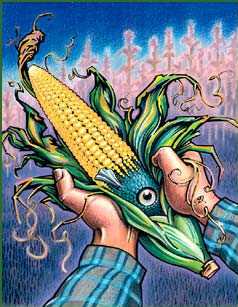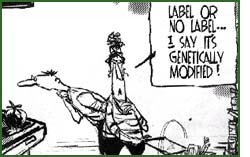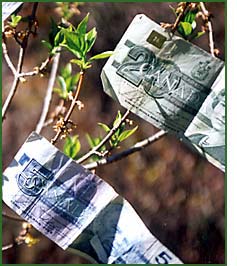|
My hands hover over six different kinds of scrubbed clean potatoes at my local grocery store. I pause to wonder if any of the vegetables, products of Canada and the USA, are genetically modified. There's a consumer info poster above the bins pointing out that the humble potato is high in potassium. This is a healthy thing apparently. But the poster doesn't say anything about agricultural biotechnology, the new science that changes the genetic structure of potatoes and other crops to make them resistant to insects and disease-causing viruses, and immune to certain herbicides. The produce clerk said that none of the potatoes were genetically modified. But he could be wrong since 10 to 20 percent of Canadian potatoes are from genetically modified (GM) varieties. The U.S. GM crop percentages are much higher, the highest in the world. Biotech crops have been grown in Canada since 1995. By the year 2000, nearly half of the corn, 25 percent of the soybeans and 75 percent of the canola grown here was modified. Many processed foods - from salad dressing to soups to soda pop - contain corn starch, corn gluten, potato starch, soymeal, soya protein or vegetable oils made from soya or canola. As a result, anywhere from 60 to 75 percent of the many foods packed into the wide aisles of the average Canadian grocery store contain some GM ingredients. But check the labels. You won't read "made better by biotechnology" or "enhanced through genetic engineering." This flies in the face of the public's desire for labeling. According to an Environics poll released in January 2000, 95 percent of Canadians think GM foods should be labeled. Consumers want to have the choice to make up their own minds. Yet the biotech and food industries have strongly and successfully opposed mandatory labeling. Major Canadian grocery chains such as Loblaws have gone one step further - they slap blank stickers over any packaging that promotes a product as 'GM-free.' The Canadian Council of Grocery Distributors defends this action by saying it's too difficult, in the absence of clear criteria, to prove if a GM-free label is accurate. Even the Canadian
Biotechnology Advisory Committee, a federal government commission, is
calling for a gradual and voluntary approach to the labeling of foods that
contain GM products - not a mandatory system.
Many in the biotechnology industry believe that mandatory labeling at this time would be the death knell of the GM food industry. As it is, many large food companies like McCains, Nestle, McDonalds, Burger King, KFC and Domino Pizza have quietly turned away from GM crops. They say there's nothing wrong with biotech crops and that they are only responding to customer concerns. Are they right, or do the hundreds of millions of people who already eat food made from GM crops have anything to be concerned about? Know your Biotech ABCsBefore we can begin to answer the biggest question in the GM controversy, a brief science lesson is unavoidable. So pour yourself a genetically altered drink, and get comfortable. The blueprint of life is DNA, that famous double-helix molecule packed with millions of genes. Genes contain genetic information that on their own or in groups produce proteins that trigger the growing of leaves or roots, arms or legs, or whatever the plan calls for. Think of a plant's DNA as a very long, very detailed sentence that exactly describes all of its characteristics. Plants have many of the same genes or 'words' in their sentences to describe common characteristics: roots, leaves, stems, etc. Various corn plants, for example, have nearly all the same words with a few unique words describing the different characteristics of each variety. Modern technology can now identify the individual word/gene in that DNA sentence, and allows us to write new stories.
For example, the word that describes a toxin produced by soil bacteria called Bacillus thuringiensis (Bt) has been removed and inserted into a corn plant's sentence to create a transgenic or GM variety called Bt corn. This corn now produces the soil bacteria toxin throughout the plant - when certain insects nibble on it they die. Another example of modification would be a gene from a cold water fish spliced into a vegetable such as a tomato for cold-weather hardiness. One of the main challenges of biotechnology is to ensure that the new
words are translated properly and do not adversely affect any part of the
plant's sentence. All of this is complex and there is much yet to learn
about the interactions between individual genes. One of the best places to
witness this science in action is, perhaps surprisingly, Saskatoon. From the Lab Fresh to Your TableOn a bluff high above the South Saskatchewan River lies the heart of Canada's biotechnology research industry. A dozen new buildings of glass, metal and brick make up Saskatoon's biotech research park called Innovation Place. Built primarily with provincial and federal monies, it's an impressive high-tech complex that includes the National Research Center's Plant Biotechnology Institute and Agriculture Canada's newly renovated Research Centre. Thanks to this impressive infrastructure, and an eager government that leases these specially built buildings, 40 percent of Canada's agricultural biotech firms are located here. There are dozens of experimental GM plants growing in state-of-the art greenhouses attached to nearly every building like shiny back porches. Admittance is restricted, and coded magnetic cards are needed for nearly every door. Growing inside are new insect-resistant canolas, transgenic wheats, drought-tolerant flax, disease-resistant lentils. The many labs also produce engineered bacteria designed to fight plant diseases. These certainly sound like good things. And on the surface, these novel plants look perfectly normal. While the technology does produce some nasty-looking mutants, they usually don't survive on their own or are destroyed. But it's not a precise business. When farmers started buying Bt corn
seeds and growing them in Canada in 1996, they didn't yield as well as
non-GM corn and they often toppled over in high winds. Researchers continued
to tweak the genome (the entire genetic material of an organism) until those
problems were solved. There's Money in That There GenomeThere is the power of creation in DNA, and thousands of researchers are intent on harnessing its potential. The science of biotechnology is less than 20 years old, but biotech agricultural products already account for annual worldwide sales of $10 billion. And that's just the beginning. Like the arms race of the cold war, there is a genes race going on today. Many countries - in both the First and the Third World - have biotech labs, all feverishly identifying and manipulating genes, filing patents on them, and hoping to mine riches and benefits out of the earth's collective gene bank. Obviously an awful lot of time, scientific expertise and money went into the development of GM crops like Bt corn. The federal and provincial governments enthusiastically backed this technology and have invested billions of dollars. While government and university scientists conducted much of the initial research in biotechnology, companies like Monsanto, Dow Chemical, Novartis, Dupont and AgrEvo, have also spent billions. Why? These companies are some of the world's biggest chemical manufacturers, and face an increasing backlash over the environmental impacts of their products, not to mention competition from low-cost producers. So in the 1990s these giant chemical companies reinvented themselves as 'life sciences' corporations and turned to molecular engineering to create new products once U.S. law allowed the patenting of seeds and other biotech products. When farmers plant Monsanto's herbicide-resistant canola, for example, they buy the seed, pay a technology license fee, and use Monsanto's herbicide. In fact, many of these new crops are engineered to be dependent on a particular brand of herbicide, conveniently owned by the same company that owns the GM seeds. The farmer is also forbidden from saving seed from his or her crops for planting the following year, because the plant's unique genetic structure is owned by the corporation. It's a lucrative scheme, and worldwide sales of GM crops are projected to hit $200 billion by 2010. To biotech critics, these enormous investments and the huge profit potential puts enormous pressure on government health and safety regulators to allow the commercialization of these products. This little piggy must go to market. Politics Grows on TreesOne of those critics is Ann Clark, a professor of crop science at the 125-year-old Ontario Agricultural College at the University of Guelph. Clark is one of the few dissenting voices among her colleagues at Canada's oldest and largest agricultural school. She is also a founding member of Genetic Engineering Alert, an independent group of scientists, academics, and agricultural professionals committed to informing Canadians about the implications of agricultural genetic engineering.
Universities have suffered through years of public funding cuts and are now much more dependent on funds from the corporate sector. This has had a significant effect on academic freedom and the willingness to go public on GM issues. Both the government and her own dean have publicly disagreed with Clark's studies that find fault with the way the federal government is regulating GM foods. GM food safety is based "largely on assumptions and inference rather than on any sort of actual testing" Clark says. Better known critics include His Royal Highness the Prince of Wales and scientist and TV personality David Suzuki. Suzuki warns that this new science is not an extension of the ancient techniques that created new plant hybrids. "A pig cannot normally exchange genes with a plant, but now biotechnology makes it possible. But without an evolutionary context, we can no longer predict how the transferred gene will behave. Unlike drugs that are found to be unsafe and can be pulled from the market, genetically modified food crops are living creatures and cannot be recalled." Canada has two watchdogs regulating GM crops and foods, the Canadian Food Inspection Agency and the Health Protection Branch of Health Canada. Neither does any actual testing. Instead, they review results of testing done by companies wanting to sell their GM products. Aside from the suspicion that companies might only reveal their best data, once a GM crop is considered "substantially equivalent" to unmodified crops no further testing is required. Although the industry claims GM foods are extensively tested, there has been little third party testing. Critics say there has been insufficient research on potential ecological impacts, and not enough testing on the long-term ramifications for human health. It could be argued that the Canadian government is in a conflict of interest as both regulator and biotech booster. Is the fox in charge of the genetically modified chickens? Even the Canadian Biotechnology Advisory Committee criticizes a "perception of mandate conflict" in the federal government, which both tests GM foods and promotes new Canadian GM products abroad. And while it is true there isn't any evidence that eating GM foods has harmed anyone, it's very difficult to connect an illness to a GM crop, and without labeling such evidence will be that much harder to find.
Beyond the philosophical questions - can a vegetarian eat a tomato grown with an animal gene - there are more down-to-earth concerns about allergies crossing genetic borders. For instance, if a nut gene is spliced into another plant species, could
someone with severe
nut allergies be at risk? These are complex questions that require
considerable research. But while there is an absence of evidence on human
impacts, there is growing evidence that GM crops are having an impact on the
environment. Escape of the Gene GenieOne of the most contentious issues is pollen. The pollen from GM crops contains the plant's unique genetics. As any allergy sufferer can tell you, pollen is highly mobile, blowing in the wind - or spread by insects. This pollen can and has landed on receptive wild plants, transferring those unique genetics. This is the so-called 'superweed scenario,' where a weed becomes resistant to herbicides or insects. Only three years ago scientists believed this would be so rare an occurrence as to rule it out as a significant risk. But when actual studies were done, it turned out that some GM plants are particularly adept at transferring their genes to wild relatives. In 1997, Tony Huether planted three different herbicide-resistant canola crops in three different fields at his farm near Sexsmith in northern Alberta. Two years later all his fields spontaneously produced canola plants that were resistant to all three herbicides. Natural cross-breeding had quickly produced something genetic engineering hadn't. Huether no longer grows GM canola.
There are risks, but there must also be benefits, or why bother with the whole enterprise. The selling point to farmers has always been that if they grow genetically modified crops they will have higher yields and can cut pesticide use. This would reduce costs, help the environment and reduce personal health risks. However, the food reviews have been mixed so far. GM crops haven't reduced pesticides much, only changed the types of chemicals used. Herbicide usage by GM soybean growers was two to five times higher than non-GM growers in 1996-98, according to agricultural expert Charles Benbrook, former executive director of the U.S. National Academy of Sciences' Board on Agriculture. Corn is not normally sprayed because of the high costs of insecticides, so the 20 million of acres of Bt corn may have reduced insecticide use by just one or two percent. Other studies show that while some GM crops have in fact produced higher yields, others have reaped yields lower than conventional varieties. And the growing consumer backlash - especially in Europe - has cost farmers some overseas markets. But with more research, biotech foods could hold the promise of
dramatically increased yields, and are offered as a way to
feed a burgeoning world population. Hunger PainsVandana Shiva, a physicist and India's best-known environmentalist, insists biotechnology will be a disaster for the people of India and the developing world. She believes it means increased corporate control over the food supply because a few multinational corporations will own the seeds and patents.
Biotech foods are too ecologically risky, Shiva argues. And they offer a false hope - they won't feed a hungry world. Hunger and malnutrition affects over 800 million people in the developing world. Not because there's a lack of food, but because of very complex issues about who grows food, how it is grow, and where. Paradoxically, many countries that export cash crops have high levels of hunger. Food such as bananas, coffee and pineapples are shipped overseas to earn foreign dollars to pay foreign debt. And in North America and Europe, farmers idle millions of acres of farmland when crop prices drop too low as a result of huge food surpluses - the infamous butter mountains and milk lakes. Contrary to the myth of modern agriculture, small farmers working with natural biodiversity can be as bountiful - or even more productive - than industrial monocultures, Shiva says. "Planting only one crop in the entire field as a monoculture will of course increase its individual yield. Planting multiple crops in a mixture will have low yields of individual crops, but will have a high total output of food." She offers the example of Mayan peasants in the Chiapas, Mexico who are considered unproductive farmers because they produce only two tons of corn per acre. However, their overall food output is 20 tons per acre when their beans, squash and fruit trees - all grown in an integrated system in the same field - are taken into account "And we don't need the so-called 'golden rice,' a new genetically engineered rice with Vitamin A to help cure blindness in children," adds Shiva. While there is Vitamin A deficiency in parts of the Third World, nature provides the vitamin in abundance in many native plants. The $100 million spent on developing 'golden rice' would have been better used in educating people about vitamins and importance of a varied diet. Moreover, India's small farmers grow thousands of different types of rice that suit their specific needs and locale, Shiva says. Diversity and a healthy variety of food remains the best strategy for preventing drought and desertification. Miguel Altieri, a professor at the University of California, agrees. He has studied alternative agricultural systems throughout Latin America. Cuba, coping with a decades-long U.S. trade embargo, and too cash-strapped to buy expensive chemicals, has developed creative integrated farming methods.
Altieri is convinced these methods could feed the world's mushrooming population. "The Latin American data shows very clearly that you can." Another alternative to GM crops is organic farming. It's a myth that organic farming is inefficient, claims Rod MacRae, a food production expert formerly with the Toronto Public Health Department. On average, he calculates, yields are only 10 percent less than conventional agriculture. That result is remarkable, MacRae says, since there is virtually no government-funded research or support in Canada or the U.S. for improving organic production methods - unlike the tens of billions spent on conventional and biotech farming. Imagine if the billions of dollars had gone to a Saskatoon Centre for
Organic Agriculture instead? You Want Fries With That?Demand for organic foods in North America outstrips the number of farmers who are currently harvesting organic produce. And this demand is growing as a result of general "eater anxiety," says MacRae, who is also co-author of the book Real Food for a Change. Worries about GM foods are part of larger concerns about the whole food production system - pesticide residues, antibiotics in meat, dangerous bacteria like E coli. More people are popping nutritional supplements and vitamin pills, and buying into health food and organic vegetables. MacRae thinks we're on the cusp of a food revolution, and GM foods just may be the trigger. "One dramatic piece of bad news will tip the balance." Maybe it was eater anxiety that made me pass on GMO foods such as the potatoes at my supermarket. Instead, I went to a local farmers market, spent an enjoyable morning talking to farmers, and bought a 50lb bag of organic spuds. Later in my kitchen, I tried out a new recipe. The edible revolution tastes pretty good to me. Stephen Leahy is a freelance writer specializing in science, the environment and agriculture. Originally written in summer, 2000. Updated August 2001 |
 Maybe you can mix apples and oranges after all.
And, thanks to science, corn and fish. But
Maybe you can mix apples and oranges after all.
And, thanks to science, corn and fish. But
 It's unlikely that Canadian foods will ever be
labeled without a wholesale revolt by the public.
It's unlikely that Canadian foods will ever be
labeled without a wholesale revolt by the public.  Scientists
are taking genes from one species and inserting them into entirely
different species, to transplant a desired 'personality trait.'
Scientists
are taking genes from one species and inserting them into entirely
different species, to transplant a desired 'personality trait.'
 But it's not simply a matter of scientific
disagreement; science, politics and money have become intertwined not
unlike DNA's double helix.
But it's not simply a matter of scientific
disagreement; science, politics and money have become intertwined not
unlike DNA's double helix.

 If resistance to plant viruses is accidentally
transferred to weeds, it could create havoc for farmers - and for
natural ecosystems.
If resistance to plant viruses is accidentally
transferred to weeds, it could create havoc for farmers - and for
natural ecosystems.

 Necessity is indeed the mother of invention. Many
Cuban farmers grow three crops together in the same field and enjoy
double the yield of conventional monocultures.
Necessity is indeed the mother of invention. Many
Cuban farmers grow three crops together in the same field and enjoy
double the yield of conventional monocultures.